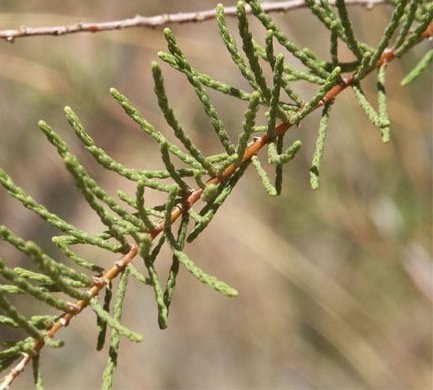Salt cedar
(Tamarix karelinii)

Description
Tamarix ramosissima, commonly known as saltcedar salt cedar, or tamarisk, is a deciduous arching shrub with reddish stems, feathery, pale green foliage, and characteristic small pink flowers. Tamarix ramosissima is a hardy shrub or small tree native to Europe and Asia. It is a vigorous, deciduous shrub grown for its ornamental reddish stems, its showy plumes of flowers, and its unusual feathery leaves. Its hardiness and tolerance for poor soil make it a popular, easy to grow shrub. It can grow up to 8 m in height and up to 5 m in width. It can be used as a screen, windbreak, informal hedge or specimen shrub. It produces upright racemes of small, pink, five-petaled flowers from late summer to early autumn which cover the new wood of the plant. It is tolerant of many soil types, but prefers a well-drained, light or sandy soil in full sun. This plant is considered an invasive species in warmer climates. Tamarix ramosissima is a major invasive plant species in the Southwestern United States and Desert Region of California, consuming large amounts of groundwater in riparian and oases habitats. The balance and strength of the native flora and fauna are being helped by various restoration projects, by removing tamarisk groves as if they were noxious weeds. Recent scientific investigations have generally concluded that the primary human-caused impact to desert riparian ecosystems within the Colorado River Basin is the alteration of the flood regime by dams; Tamarix ramosissima is relatively tolerant of this hydrologic alteration compared to flood-dependent native woody riparian species such as willow, cottonwood, and box elder. Research on competition between tamarisk seedlings and co-occurring native trees has found that Tamarix seedlings are not competitive over a range of environments, but stands of mature trees effectively prevent native species' establishment in the understory, due to low light, elevated salinity, and possibly changes to the soil biota.Box elder (Acer negundo, a native riparian tree) seedlings survive and grow under higher-shade conditions than Tamarix seedlings, and mature Tamarix specimens die after 1–2 years of 98% shade, indicating a pathway for successional replacement of Tamarix by box elder. Anthropogenic activities that preferentially favor tamarisk (such as changes to flooding regimens) are associated with infestation.
Taxonomic tree:







